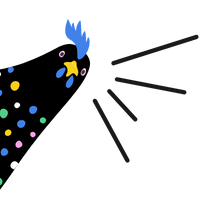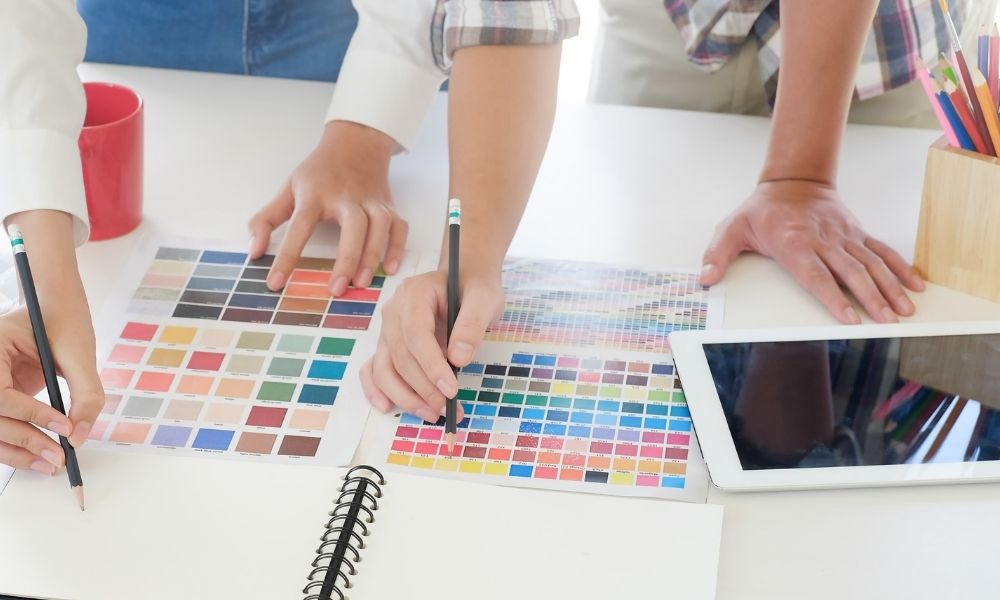Create a Kickass Small Business Brand Identity Kit with This Guide!
Launching a new business or rebranding your small business to be more competitive in 2022? Then you’ll need to score a kickass small business brand identity kit to help you win customers, impress investors, and prove that your brand is trustworthy and LEGIT! We highly recommend investing in high-quality brand kit elements from the start to save yourself plenty of time, money, and heartache! We’ve been the shoulder that many a small biz cries on after having to rebrand—it’s no fun, trust us!
But what will you get when you pay from professional small business branding? What are the main elements of a small business logo package, and how will it help you grow your biz in 2022? Is it truly worth your money to invest in professional branding when you could just hire someone cheap on Fiverr?
In this guide, we’ll spill ALL THE TEA about small business brand identity kits! We’ll tell you what exactly they ARE, what you’ll get when you work with a designer to create brand guidelines, plus some tips for finding a perfect-fit branding agency in 2022. Let’s dive in, shall we!?
Why Do I Need a Small Business Brand Identity Kit, Anyway?
Most of us know what a logo is, but brand guidelines or a “brand kit”, “brand identity kit”, or “brand identity guidelines” are more elusive. Your small business brand identity kit is typically presented in a PDF or web-based document. It summarizes not only your logo, but the entire visual identity of your brand at-a-glance. Including the visual guidance components you’ll need to keep your brand identity consistent across a variety of different channels, like your website, social media, advertisements, packaging, and email campaigns, to name a few.
Your brand identity kit can also help you define and communicate the look, feel, and message of your small business for:
- Company leadership (including yourself!)
- The designers and developers working on your website
- Future freelancers and employees
- Potential Investors or Mentors
- Media outlets that will (if you play your cards right) spread the word about your business
Learn More: WHAT ARE BRAND GUIDELINES? FIVE SMALL BIZ BRAND STRATEGY ESSENTIALS

11 Elements For a Solid Brand Identity Kit
So which brand kit elements should your brand identity kit include? While the packages offered by different agencies and freelancers will vary, these 11 elements are the most common you should expect to receive.
The complexity of your brand kit will depend on your budget and current needs. You may not need all of these elements to launch your business, but as you grow you’ll want to plan to expand your brand kit accordingly!


1. Your Main Logo Concept
Your designer will usually draft at least 3 different logo concepts for you to review before crafting a final logo design. They will listen to your feedback about the specific design elements you like or dislike in each concept. They may also offer their professional opinion; tips and examples for better branding based on their experience. Listen to them! But also remember that, in the end, it’s always your decision.
You should get a few rounds of revisions in which to tweak your logo design so your final logo is exactly what you want. Make sure you are completely clear on how many rounds of revision are included in your branding package. Some packages do not include any revisions and you’ll be charged hourly to make changes. Ouch!
Once you approve your final logo version, these are the small business brand identity kit elements you should get from your designer:
- High-resolution Logo Files You will need high res files so your logo looks great both blown up larger for signs or shrunk down smaller for print or social media.
- Multiple File Formats You will need several different high-res file formats (TIFFs, PNGs, PDFs, and JPEGs) for use in social media designs, advertising, and on your website.
- Different Logo Color Variations We suggest getting your logo in a dark color, a light color, and a few brighter color pops. We usually make sure to include these in our color palettes, but basic black and white versions work, too. You’ll find that you need this wide range to layer over different photo types for social media and your website.
2. Alternative Logo or Watermark
If you have a unique use case for your logo, you might want to ask your designer for an alternative logo version or two to satisfy all your needs.
How Do I Know If I Need an Alt Logo or Watermark?
- Do you need a simpler alternative logo? If it needs to be on the side of a truck or on a large-scale digital billboard, you might want a simplified version of your logo that can be seen clearly from a distance. Similarly, if your logo includes an illustration, you might want a typography-only version for social media use.
- Do you require a watermark? Watermarks can be a simpler or slightly transparent version of your logo. Watermarks are a great way to include your logo on social media images and videos.
- Does your logo need to be adaptable to suit different product lines? Some brands, like Crabtree & Evelyn, choose to use their logo in different forms and colors to appeal to a broad customer base. Do you serve men and women with different product lines? Do you have different courses or service packages you’d like branded uniquely?
3. Logo Usage Guidelines
Logo usage guidelines stipulate how can your logo be used in its different forms. And how it cannot be used.
- Should specific logo colors or versions be used for specific applications? For example, maybe you only use a simplified logo that is easy to see on mobile for social media posts?
- How should your logo appear when applied to different types of images or designs? Should it always be a certain color on lighter images?
- What are the rules for spacing and borders? Should your logo never be placed less than 20 pixels from the outside border of an image?
- How close can your logo be to unbranded text in a design? Can images with your logo on them contain outside text—like a newspaper or graffiti?
- What is the smallest and largest size your designer recommends for logo usage? Should your logo never be less than 100×100 pixels?


4. Color Palette and Color Codes
Your color palette is one of the most essential brand kit elements. It’s a grouping of complementary colors that will appear in your logo, on your website, and on your packaging or any other design elements.
Make sure your designer includes hex codes for online use (like your website and email campaigns), as well as CMYK for printed materials (like packaging, inserts, or mailers) in your brand kit. You’ll likely need to pass these color codes along to design and development professionals in the future. Your designer will also usually include suggested lighter and darker versions of your color palette that can be used for different applications, as in the example below.
When speaking with your designer about your color palette, keep in mind what message your colors will send. Your color palette should evoke the emotion and “vibe” of your brand. If you’re selling cosmetics you might want to use calming, soft pastel pink or blue.
OR you might want your beauty brand to feel more energetic, with bright orange, fuchsia, and turquoise tones. It all depends on your target customer demographic. A talented branding agency can always help you decide! Creating your small business brand identity kit is a highly personalized and individual experience!
What Do These Common Colors Say To Your Audience?
- Red/Orange = Passionate, loud, high energy, exciting
- Yellow = Happy, fun, whimsical, awake, warm, and tropical
- Green = Natural, fresh, genuine, healthy
- Blue = Trustworthy, reliable, mature, traditional
- Purple = Luxurious, high-end
- Pink = Soft or feminine
- Black = Sophisticated, strong, bold, modern
5. Color Usage Guidelines
How will you use the colors in your color palette? Color usage guidelines should be provided by your designer and are an important element of your small business brand identity kit you MUST receive from your designer. Especially if you use a lot of bright or contrasting colors that can potentially be hard to view or clash if used incorrectly.
Your designer will likely give you do’s and don’ts for color usage in your brand kit—this will include which colors of logo go best with which palette tone.


6. Typography and Fonts
You should receive a font suggestion for headlines, subheads, and paragraph copy. This is very useful for your website. Make sure to use web-approved fonts so that your website will appear correctly on all internet browsers and email servers. And use the same fonts on your website, social media, and in any other marketing materials to maintain consistency.
Popular font types:
- Serif More traditional lettering with anchors on each letter. If each letter has a tail or a “tie”, as we sometimes say, then it’s a serif font.
- Sans serif Modern lettering that does not have anchors on each letter. Think block lettering or masculine, bold fonts.
- Script typography Fancy lettering—think cursive or handwriting style fonts. We usually describe this type of font as “swoopy”! Very technical.
- Display fonts Includes more unusual elements like shadows, outlines, and hand-drawn fonts. These will usually be used sparingly as headlines or design elements on a web page or print materials.
7. Mood Board
Your mood board is a collection of images and other visual elements that your designer will create to convey the mood of your brand.
You can help your designer out by sending them photography you vibe with to get them started in the right direction. You can also supply images, Insta feeds, or websites that you love.
When brainstorming for your mood board, your designer might ask you if you see your brand as a certain “mood” or combination of descriptors like:
- Fun, vibrant, bright, cheerful
- Dark, brooding, witchy, sultry
- Girly, neon, flirty, sassy
- Light, airy, pastel, dreamy
- Earthy, grounded, natural, honest
8. Photography Guidelines
These do’s and don’ts help different teams know how to maintain cohesive branding across all channels, including your website, social media, and ads. These guidelines should ideally be stipulated by your designer as a brand kit element.
Here are some questions your photography and design guidelines might answer:
- Does your brand prefer lifestyle images or sweeping landscapes? Should photos be friendly and approachable or luxurious and aspirational?
- Are there different photography rules for social media vs. your website?
- Should images always be edited in a certain way to complement your logo? What tone should images have? What types of image subject matter are on-brand vs. image types that are not representative of your brand mood?
- Should images used with your brand avoid any political statement or the use of drugs or alcohol?
- Should images be inclusive—is it important to your brand to feature images of all gender identities, body shapes, and skin tones?


9. Shapes, Textures, Patterns, and Other Special Design Elements
Does your brand plan to use organic or angular shapes for icons, social media imagery, and packaging? Are there brand-specific texture and pattern elements that you will want to incorporate?
If you know these are things you’ll want, it’s best to have your designer make them at the same time they are crafting your other brand kit elements. They can deliver a .pdf or other friendly file type to help you craft on-brand images and social media designs.
10. Editorial Style Guidelines & Messaging
Editorial style guidelines and brand messaging are often included in premium brand kits. These guidelines establish rules for written content and help keep the messaging for your brand kit true to your editorial vision. This part of your brand identity will be most useful for freelancers, new employees, and the media, who will all need guidance when writing about your brand.
You should think about:
- The voice and tone of your brand’s written assets. Should your website and social media copy be friendly and approachable? Elite and luxurious? Or perhaps educated and qualified?
- The vocabulary of your brand. Are there words that you really love used or words that you completely hate and do not want used to describe your brand?
- Your brand’s mission, vision, and guiding principles. These can be summarized in your brand identity kit.
- Are there strict formatting and punctuation preferences for your brand? Do your headlines always appear in all lowercase? Do you use the Oxford Comma in all written brand assets? Decide this and include it in your editorial guidelines!


How Much Does a Brand Kit Cost?
Typically, professional brand kits start at $3-5K. But for businesses that need more of these brand kit elements, like an editorial style guide, it can reach $10-15K or more. And it’s money well spent.
You can control your spend by only paying for the brand kit elements you need right now—like a logo, color palette, and fonts. You can always expand your kit down the line, but make sure the elements you do have are high-quality.
For more in-depth info on the cost of brand kit elements, check out HOW MUCH DOES BRANDING COST FOR SMALL BUSINESSES??


Who Should I Hire to Create My Small Business Brand Identity Kit?
Whatever you do, don’t hire someone to make your logo on Fiverr. You’ll likely have to rebrand your business within a year when you grow. If you go cheap, just have realistic expectations of how much you’ll need to spend down the line to repair your brand image.
You’ll use your small business brand identity kit to inform your entire digital marketing strategy, so it better REPRESENT. Combined with a great website and SEO strategy, this kit is going to be the basis of your entire small biz vibe. Rebranding means thousands of alienated customers who might lose trust and recognition of your business. It also means more budget spent on branding, and possibly having to completely rebuild or reskin social handles and your website. Ugh. No fun! Just do it right the first time.
Need help crafting a professional brand identity kit that contains these key brand kit elements? We provide uh-mah-zing branding kits and even offer brand consulting and strategy services to develop your business’s future name and website URL. Need a logo for your woman-owned business? We especially adore working with other women-owned businesses to create elevated, feminine logo and branding packages. Or sustainable businesses that are passionate about being environmentally responsible and ethically aware. If you fall into those two categories, LoudBird just might be your ideal branding agency! Let’s chat!


